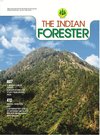Macro-mycoflora associated with Pinus kesiya Royle ex Gordon (Khasi pine) stands of Meghalaya, India
DOI:
https://doi.org/10.36808/if/2018/v144i4/129441Keywords:
No Keywords.Abstract
No Abstract.References
Agrahar M.D. and Subbulakshmi G. (2005). Nutritional value of edible wild mushrooms collected from the Khasi hills of Meghalaya. Food Chem., 89: 599-603.
Bisht N.S. (2011). Wood decaying fungi of Mizoram. Environment and Forest Department, Mizoram, India. iv+98 p.
Borovièka J., Kotrba P., Gryndler M., Mihaljeviè M., Øanda Z., Rohovec J., Cajthaml T., Stijve T. and Dunn C.E. (2010). Bioaccumulation of silver in ectomycorrhizal and saprobic macrofungi from pristine and polluted areas. Science of the Total Environment, 408(13): 2733-2744. https://doi.org/10.1016/j.scitotenv.2010.02.031
Boruah P., Adhikary R.K., Kalita P. and Bordoloi D. (1996). Some edible fungi growing in the forest of East Khasi Hills (Meghalaya). Advances in Forestry Research in India, 14: 214–219.
Das K., Lamo A., Paul D. and Jha L. (2014). Ethnomycological Knowledge on Wild Edible Mushroom of Khasi Tribes of Meghalaya, North-Eastern India. European Academic Research: 3433–3443.
Forest Survey of India. (2008). State of Forest Report 2005. http://fsi.nic.in/sfr2005/meghalaya.pdf (Accessed on 05 November, 2017).
Kalita K., Bezbaroa R.N., Kumar R. and Pandey S. (2016). Documentation of wild edible mushrooms from Meghalaya, Northeast India. Current Research in Environmental and Applied Mycology, 6(4): 238–247.
Khaund P. and. Joshi SR. (2013). Wild edible macrofungal species consumed by the Khasi tribe of Meghalaya, India. Indian J. Nat. Prod. Resour., 4: 197–204.
Kumar R., Bisht N.S., Pandey S. and Tapwal A. (2015a). Mushrooms of Nagaland. Indian Forester, P.O. New Forest, Dehradun. p. viii+146.
Kumar R., Pandey S., Rishi R., Giri K. and Mishra G. (2015b). Unrecorded macrofungi from the Narpuh Reserve Forest of Meghalaya, India. Current Life Sciences, 1: 118–123.
Kumar R., Giri K. and Pandey S. (2017). First report on four Macrofungi from Meghalaya, North East India. Arch. Life Sci. & Env., 1(2): 51-56
Mueller G.M., Schmit J.P., Leacock P.R., Buyck B., Cifuentes J., Desjardin D.E., Halling R.E., Hjortstam K., Iturriaga T., Larsson K., Jean Lodge D., May T.W., Minter D., Rajchenberg M., Redhead S.A., Ryvarden L., Trappe J.M., Watling R. and Wu Q. (2007). Global diversity and distribution of macrofungi. Biodiversity and Conservation, 16(1): 37-48. https://doi.org/10.1007/s10531-006-9108-8
Schmit J.P. and Mueller G.M. (2007). An estimate of the lower limit of global fungal diversity. Biodivers. Conserv., 16(1): 99–111. https://doi.org/10.1007/s10531-006-9129-3
Sharma J.R. (2012). Aphyllophorales of Himalaya (auriscalpiaceae – Tremellodendropsis). Botanical Survey of India, MoEF. p. xxxv+580.
Downloads
Downloads
Published
How to Cite
Issue
Section
License
Unless otherwise stated, copyright or similar rights in all materials presented on the site, including graphical images, are owned by Indian Forester.





